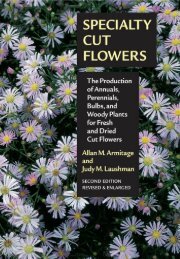Create successful ePaper yourself
Turn your PDF publications into a flip-book with our unique Google optimized e-Paper software.
CHAPTER 3<br />
Plant histology<br />
Disttibution of cells and tissues<br />
The vascular plant is composed of dermal, ground<br />
and vascular tissue systems (3.1 to 3.4). The<br />
phloem and xylem constitute the vascular system;<br />
both arc complex tissues in which the conducting<br />
elements (2.10, 2.68, 2.69) arc associated with<br />
other cell types (1.4, 1.11,3.5). The ground system<br />
surrounds the vascular tissues (3.1 to 3.4) and<br />
comprises parenchyma, collenchyma and selecenchyma<br />
(3.6 to 3.10). The dermal system is initially<br />
represented by the epidermis (3.2, 3.3) containing<br />
various cell types (3.3, 3.lt, 3.12). Its structure is<br />
considered in Chapter 5.<br />
In plants which undergo woody thickening, the<br />
epidermis typically becomes replaced by the cork<br />
and associated tissues (the periderm, 3.13) whose<br />
structure is discussed in Chapter 6. Secretory cells<br />
do not normally develop as distinct tissues (except,<br />
for example, in nectaries) but rather occur<br />
cither as surface structures (3_11, 3.12) or within<br />
other tissues (3.4).<br />
Parenchyma<br />
These cells arc generally thin-walled and have<br />
large vacuoles (2.24, 3.3. 3.6). Thcy form a<br />
continuous tissue in the cortex and pith (1.27, 3.4)<br />
and in the leaf mesophyll (3.3), while vertical<br />
strands and horizontal rays of parenchyma occur<br />
in the vascular system (1.3, 3.14). The leaves and<br />
stem of seedlings and small herbs are largely held<br />
erect by the collective turgor of the parenchyma<br />
cells (3.3) and the shoot wilts if insufficient water<br />
is available from the root system to replace<br />
transpiration losses (1 .12).<br />
Parenchyma cells are often polyhedral or<br />
elongate (3.3, 3.6) but stellate and irregular forms<br />
occur (3.3, 3.15). The mesophyll cell of the leaf is<br />
specialised for photosynthesis and contains numcrous<br />
chloroplasts (3.3) while starch is frequently<br />
stored in the parenchyma of the root and<br />
stem (t.14). In plants growing in marshy conditions<br />
and in aquatics, the parenchyma of the<br />
shoot and root sometimes develops extensive<br />
intetcellular spaces and is termed aerenchyma<br />
(3.15).<br />
Mature parenchyma ceJls of the stem and root<br />
may resume division (3.16) and undergo partial<br />
dedifferentiation to form the lareral meristems of<br />
the phellogen and vascular cambium (3.5) from<br />
which the cork and secondary vascular tissues<br />
originate (3.13, 3.17). In some situations the<br />
parenchyma cells revert to an undifferentiated<br />
state (as found in the apical meristems, 2.2) and<br />
give rise to new plant organs. This phenomenon<br />
results in the formation of lateral and adventitious<br />
roots (3.18) and in the development of primordia<br />
(3.19) which give rise to adventitious shoots on<br />
various partS of the plant (3.20, 3.21).<br />
The development of adventitious organs is<br />
sometimes related ro injury (3.18); the plant's<br />
regenerarive capacity is exploited in horticulture<br />
by the rooting of shoot cuttings (3.J8) and regeneration<br />
from various excised plant organs (3.J9 to<br />
3.21). Parenchyma cells should therefore be<br />
regarded as potentially totipotent and single cells<br />
derived from carrot and tobacco have given rise to<br />
completely new plants when cultured in vitro on a<br />
suitable nutrient medium with exogenous growth<br />
substances.<br />
The parenchyma cell wall is often thin, with irs<br />
growth normally terminating at the end of cell<br />
vacuolation (2.24, 3.3, 3.15)_ However, in seed<br />
srorage tissue the walls may be greatly thichned<br />
(Correa, Phoenix, Phaseo/lts. 2.54) by noncellulosic<br />
reserve carbohydrates, while parenchyma<br />
cells often develop thick lignified secondary<br />
walls (1.3, 2_65) in the xylem and pith. In transfer<br />
cells labyrinthine ingrowths of the wall (2.63)<br />
vastly increase the plasmalemmal surface, while<br />
simpler vertical ingrowths of the wall also occur in<br />
the plicate mcsophyH of several conifers (3.22).<br />
Collenchyma<br />
These living cells arc thick-walled but relatively<br />
pliable (3.7) and are located in the outer ground<br />
tissue (3.23). Collenchyma is of great value in the<br />
mechanical support of the young shoot but is rare<br />
in the root. The proroplasts of such cells are<br />
generally vacuolate (3.7) while their highly<br />
hydrated primary walls are unevenly thickened<br />
(3.7, 3.24) and comain large amounts of peCtins<br />
and hemicelluloscs. Collenchyma cells are usually<br />
elongate (3.7) and in transverse section often<br />
appear angular with thickening localised in the<br />
cell corners (3.7, 3.24) but the thickening may be<br />
confined to the tangential walls (3.7). Intercellular<br />
spaces sometimes occur in collenchyma and in<br />
older cells the walls may become lignified.<br />
57





